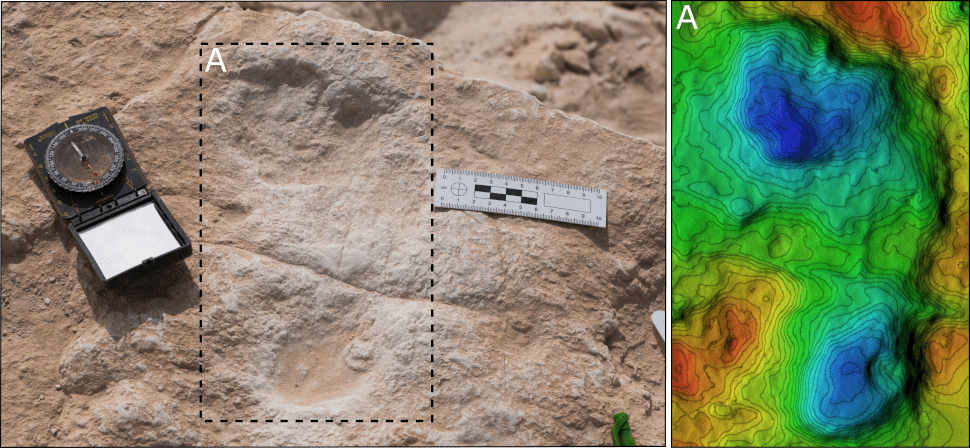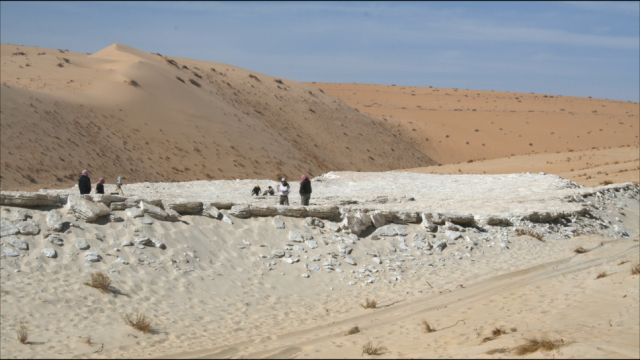Archaeologists in Saudi Arabia have discovered seven well-preserved footprints belonging to humans. Dated to around 120,000 years ago, these appear to be the oldest evidence of our species in the region.
Prior to the last ice age, somewhere between 112,000 and 122,000 years ago, two humans, possibly three, walked south along the shore of an ancient lake in what is now the western Nefud Desert of Saudi Arabia. The humans, as they crouched down to collect valuable freshwater, were not alone, as the lake had attracted elephants, horses, camels, and other animals desperate for a drink.
Their thirsts quenched, the humans departed, but not before leaving imprints of their feet in the mud flats. Same for the animals. The footprints dried out and solidified shortly afterward and then became covered in sand, preserving them for over 100,000 years.
New research published in Science Advances describes the discovery of these fossilised footprints, of which at least seven could be linked to humans, specifically Homo sapiens. The prints “most likely represent the earliest evidence of our species in the Arabian Peninsula,” wrote the authors in the study, co-led by Matthew Stewart from the Max Planck Institutes for Chemical Ecology.

The presence of these prints in the Arabian Peninsula — the gateway between Africa and Eurasia — could mark a possible migration route taken by early humans as they spilled out from their continent of origin. Accordingly, the new paper highlights the importance of the region as a conduit through which early humans would go on to populate the rest of the world.
That members of our species had already departed Africa by this time is hardly a surprise. Previous archaeological evidence shows that H. sapiens were in southern Greece by around 210,000 years ago and in the Levant by around 180,000 years ago. The only prior evidence of human activity on the Arabian Peninsula is an 88,000-year-old middle finger described in 2018. The newly discovered footprints, dated to at least 112,000 years ago, sit comfortably within these timelines.
As the scarcity of evidence suggests, however, archaeologists have much to learn about the routes taken by these pioneering humans. A migration route through the Arabian Peninsula makes sense, both from a geographical and a practical perspective. Much of Saudi Arabia has a desert climate today, but it wasn’t always that way, particularly during the last interglacial period when the region was more humid and hospitable.
“At certain times in the past, the deserts that dominate the interior of the peninsula transformed into expansive grasslands with permanent freshwater lakes and rivers,” explained Richard Clark-Wilson, a co-leader of the project and a researcher at Royal Holloway, University of London, in an MPI-CE press release. “It was during these periods of climatic upturn that human and animal populations dispersed into the interior, as shown by the archaeological and fossil record.”
Exposed by erosion, the footprints were found during an archaeological survey at the Alathar deposit, a former lake in the western Nefud Desert of Saudi Arabia. Researchers dated the sediments with optically stimulated luminescence, which produced the date range between 112,000 and 121,000 years ago.
“The site provides an amazing snapshot of modern humans and the environment immediately surrounding them in the Arabian Peninsula just over 100,000 years ago,” Kevin Hatala, an archaeologist from Chatham University in Pittsburgh who wasn’t involved in the new study, said in an email.
Of the 376 tracks found, 177 could be reliably identified, including prints left by elephants, camels, and other herbivores. The elephant tracks were actually a surprise, as elephants were thought to have become locally extinct to the region by around 400,000 years ago.
Earlier this year, Hatala and his colleagues reported on the discovery of over 400 fossilised human footprints in Tanzania, which now represents the largest collection of footprints ever found in Africa. The great thing about footprints is that they “cannot be transported, and can be far more numerous than skeletons, so they provide extra information — a potential that archaeological investigations are only recently recognising as being highly relevant,” explained archaeologist Karen Moreno from Austral University of Chile, not affiliated with the new research, in an email.
Seven tracks were identified as belonging to H. sapiens. As the paper notes, these tracks solidified after a few hours or days, and they were produced by two or three individuals travelling together.

These tracks clearly belong to humans, but it’s reasonable to ask which humans, as Neanderthals were around at the time, too. As noted earlier, archaeological evidence supports the presence of H. sapiens in the Levant by around 180,000 years ago, but no such evidence exists for Neanderthals, who were living in the northern regions of Eurasia. What’s more, an analysis of the footprints shows they’re a good match for H. sapiens, as they were produced by individuals with longer feet and less mass than Neanderthals, according to the study.
“This article is well supported by the evidence, as current information about the time of the presence of Homo sapiens in the region is coherent with the finding,” said Moreno, who knows a thing or two about fossilised footprints. Her own work involves a 15,600-year-old human footprint found in Pilauco, Chile — potentially the oldest known footprint found in the Americas.
Hatala said we can’t be absolutely certain if these footprints were made by H. sapiens, as opposed to Neanderthals or another hominin (a good point, as other human species were around at the time, including Denisovans, a sister group to Neanderthals, and Homo erectus). But, “based on their size and what is known from skeletal fossils from this approximate time and place, the authors provide a well-reasoned justification for why this attribution seems most likely,” said Hatala.
Some archaeologists, he added, might take exception to the researchers’ interpretation of the footprint patterns and the geographical context itself, but in his mind, “the team has done the best they could to offer a really fascinating glimpse of humans and their landscape in a time and place about which we currently know relatively little.”
This archaeological setting, in which human footprints were found interspersed with those left by animals, suggests this shallow freshwater lake was a popular place. Humans were congregating around the lake, possibly in response to dry conditions and dwindling water supplies, the authors speculate.
“The presence of large animals such as elephants and hippos, together with open grasslands and large water resources, may have made northern Arabia a particularly attractive place to humans moving between Africa and Eurasia,” said Michael Petraglia, a co-author of the study and a researcher at the Max Planck Institute, in the press release.
Hatala echoed these remarks, saying the fossilised human and animal footprints hint at the “types of environments that may have provided corridors for human migrations out of Africa and around the world.”
This important discovery, should it stand up to further scrutiny, adds colour to early human prehistory. There’s so much we still don’t know, but a fascinating story is starting to take shape.
